Terrariums offer a versatile canvas for creativity, blending botany with design to bring miniature ecosystems into your home or event space. From beach-themed displays that evoke coastal breezes to geometric glass vessels framing living sculptures, the possibilities are virtually endless. Materials range from repurposed light bulbs and driftwood to classic Mason jars and elegant cloches, accommodating everything from succulents and cacti to mosses and air plants. Themes such as fairy gardens, tropical oases, and seasonal dioramas let you tailor each terrarium to your personal aesthetic or special occasion. Whether you prefer low-maintenance faux greenery or hands-on workshops that double as team-building activities, you’ll find an idea here to spark your imagination and cultivate your own tiny world under glass.
1. Beachy Terrarium
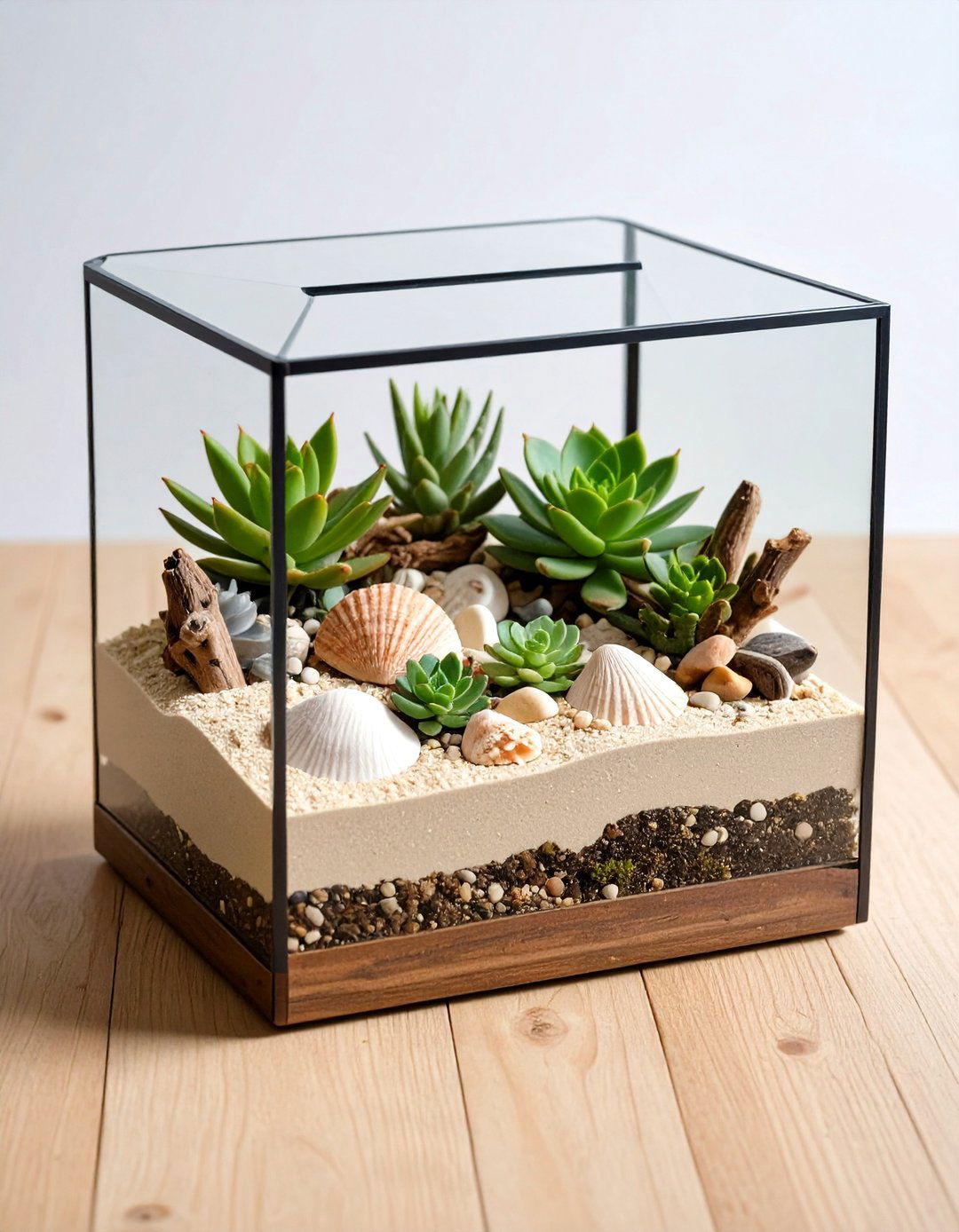
Creating a beach-inspired terrarium involves layering sand, small pebbles, and succulent-friendly soil to mimic a coastal seascape, then accenting with seashells and driftwood for authentic seaside flair. This style not only brings a touch of the ocean indoors but also benefits from the low water needs of succulents and cacti, making maintenance straightforward.
To enhance the theme, select succulents in sandy hues—such as echeveria or sedum—and arrange miniature beach umbrellas or tiny starfish ornaments on top of the sand layer. Place your terrarium in bright, indirect light to ensure the succulents thrive while preserving the soft coastal color palette.
2. Mason Jar Terrarium
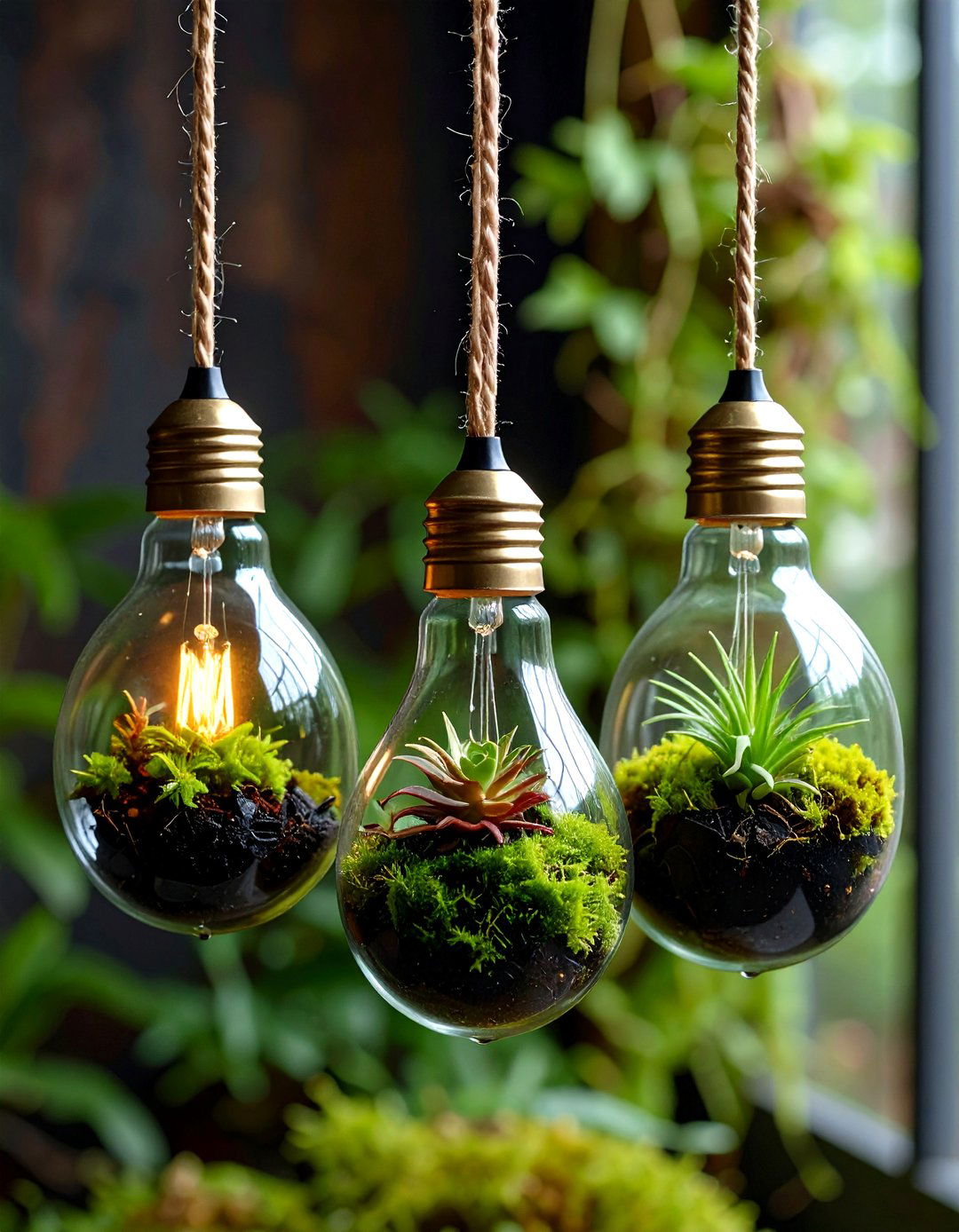
Mason jars provide an charming, budget-friendly vessel for both open and closed terrarium styles. Start with a layer of pebbles for drainage, add activated charcoal to prevent odors, then top with potting mix suited to your chosen plants. Closed Mason jar terrariums create a self-sustaining humidity cycle, ideal for moisture-loving mosses and ferns.
These compact terrariums fit perfectly on windowsills or shelves and make thoughtful gifts. Customize by painting the jar lids or wrapping twine around the neck, and use tweezers to carefully place greenery for precise arrangements.
3. Light Bulb Terrarium
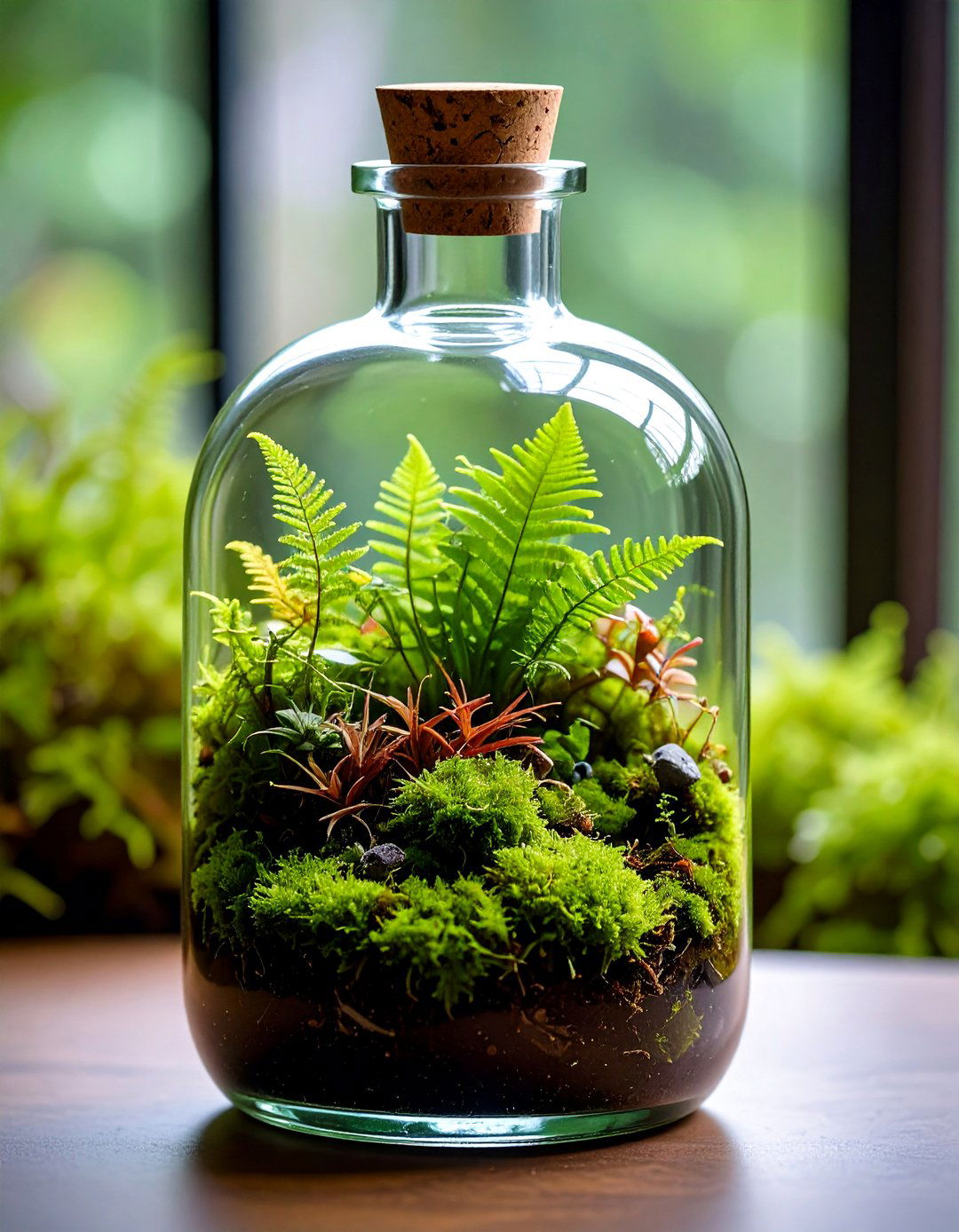
Repurposing burnt-out light bulbs as terrariums offers a whimsical, upcycled approach to planting. Carefully remove the bulb's interior and fill with a thin substrate layer, then add charcoal and soil before inserting mosses or tiny air plants. Air plants are especially suited to this style, as they require no soil and minimal watering.
Hang these delicate terrariums by threading fishing line through the bulb’s metal base or display them in a glass egg cup for a conversation-starting décor piece. The clear glass and miniature scale create an enchanting focal point in any room.
4. Succulent Sea Terrarium
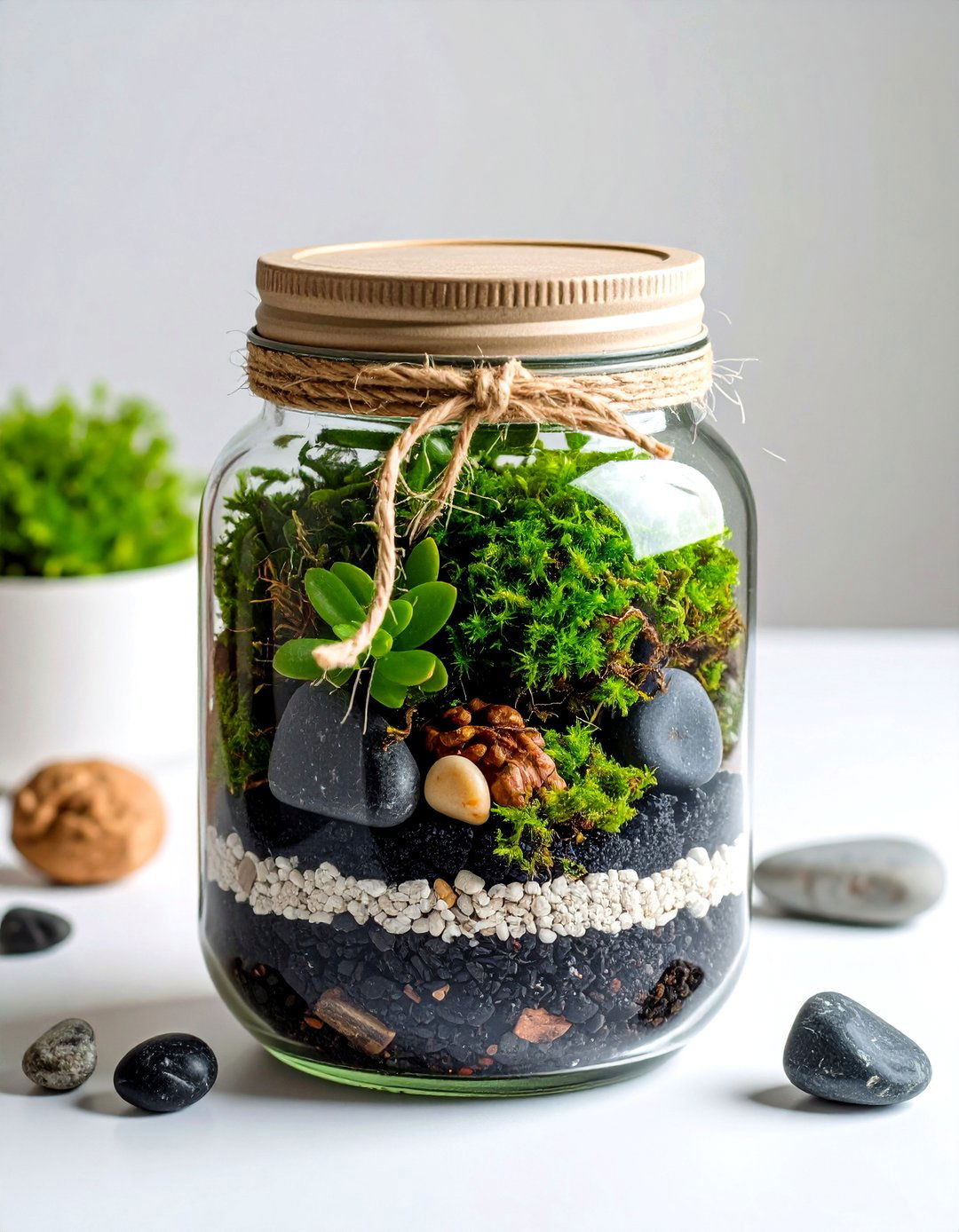
The succulent sea terrarium combines aquatic design elements with hardy desert plants. Use blue-tinted sand or decorative glass beads to simulate water, then place low-water succulents like haworthia in a “shoreline” arrangement. Accent with driftwood or miniature nautical figurines for authenticity.
Although visually reminiscent of a beach scene, this terrarium remains drought-tolerant and requires bright light and infrequent watering, making it a versatile option for those new to terrarium building.
5. Desert Diorama Terrarium
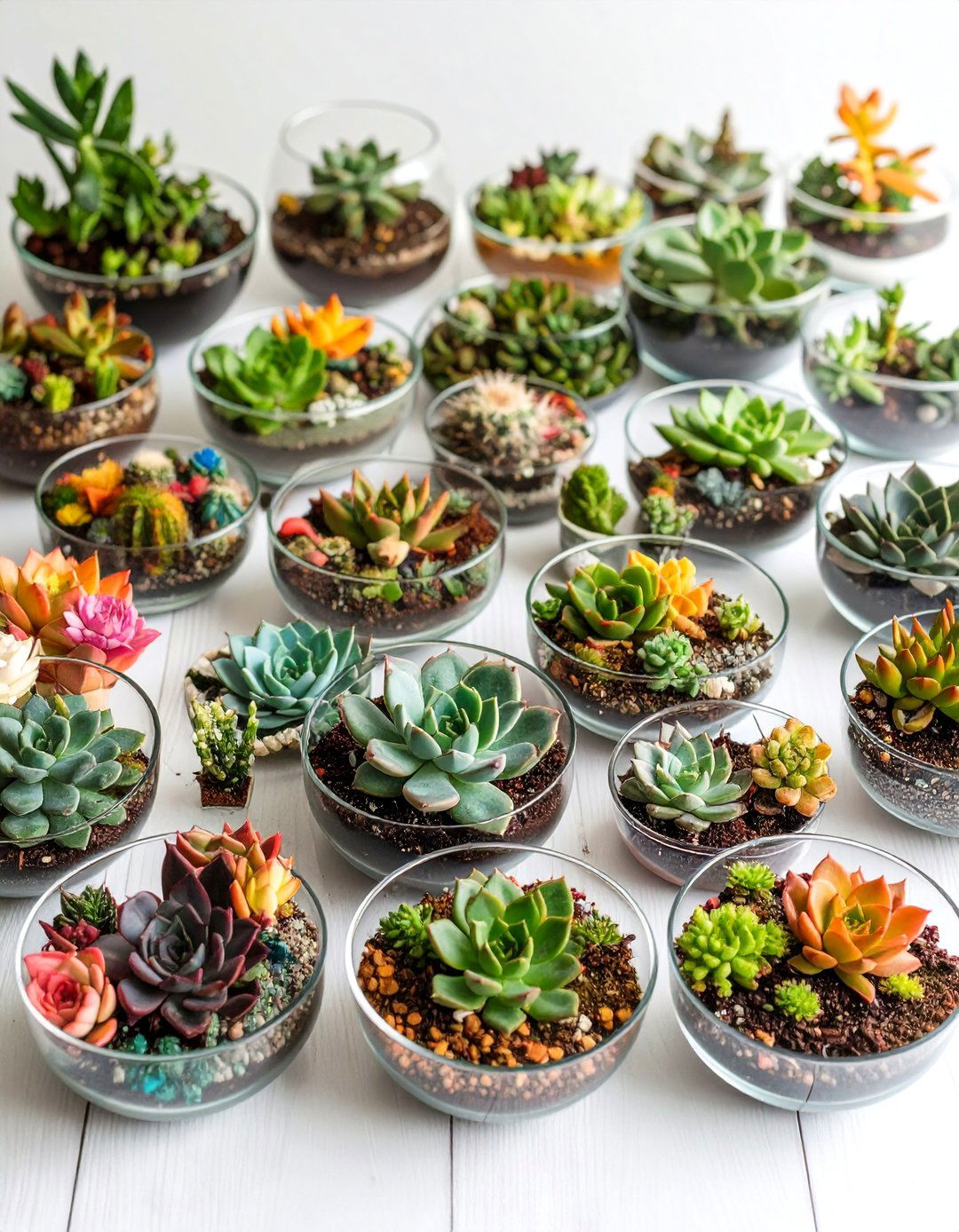
Desert diorama terrariums showcase cacti, succulents, and arid-land mosses in an open-ventilated glass container. Arrange sand, gravel, and rocky outcrops to recreate a miniature desert landscape, accenting with tiny figurines or model animals for a playful twist.
This open style prevents excess humidity and mimics the dry environment desert plants appreciate. Position in direct sunlight for several hours daily to support healthy growth and maintain the dramatic contrast between plant and mineral elements.
6. Moss Closed Terrarium

Closed moss terrariums thrive in sealed glass containers where humidity levels remain consistently high. Begin with a drainage layer of pebbles and charcoal, then add sphagnum moss and a blend of shade-tolerant plants like ferns, club moss, or baby tears.
These lush, green worlds require minimal maintenance beyond occasional misting and indirect light, making them perfect living décor for low-light interiors and busy lifestyles.
7. Hanging Air Plant Terrarium
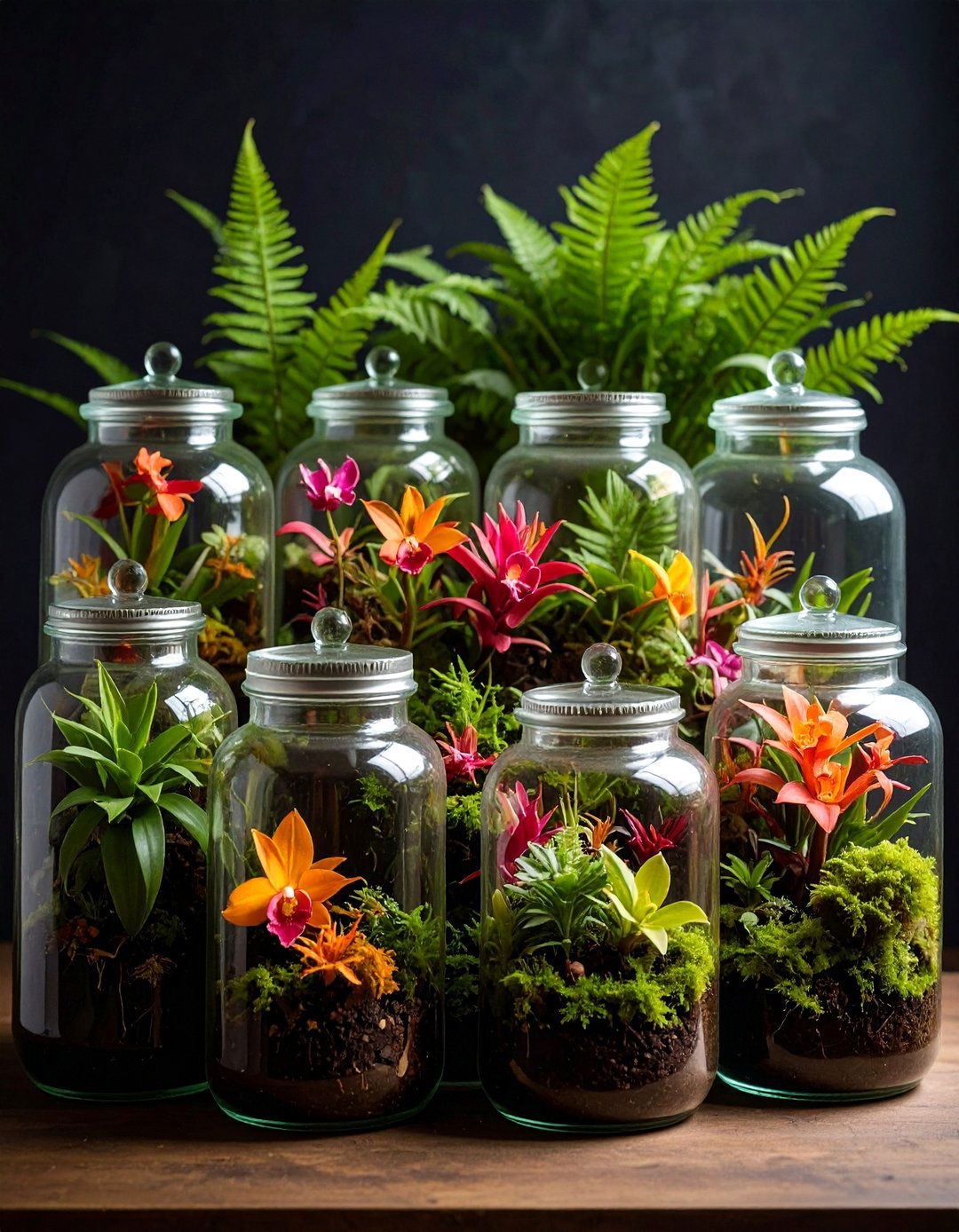
Air plant terrariums suspended in geometric glass orbs bring greenery to vertical spaces. Fill the base of the orb with decorative sand or stones, nestle in tillandsia, and hang by a leather strap or metal chain.
Air plants absorb moisture from the air and need only a weekly soak or spritz, reducing soil-related complications. Cluster multiple orbs at varying heights for a dynamic, floating garden effect.
8. Fairy Garden Terrarium
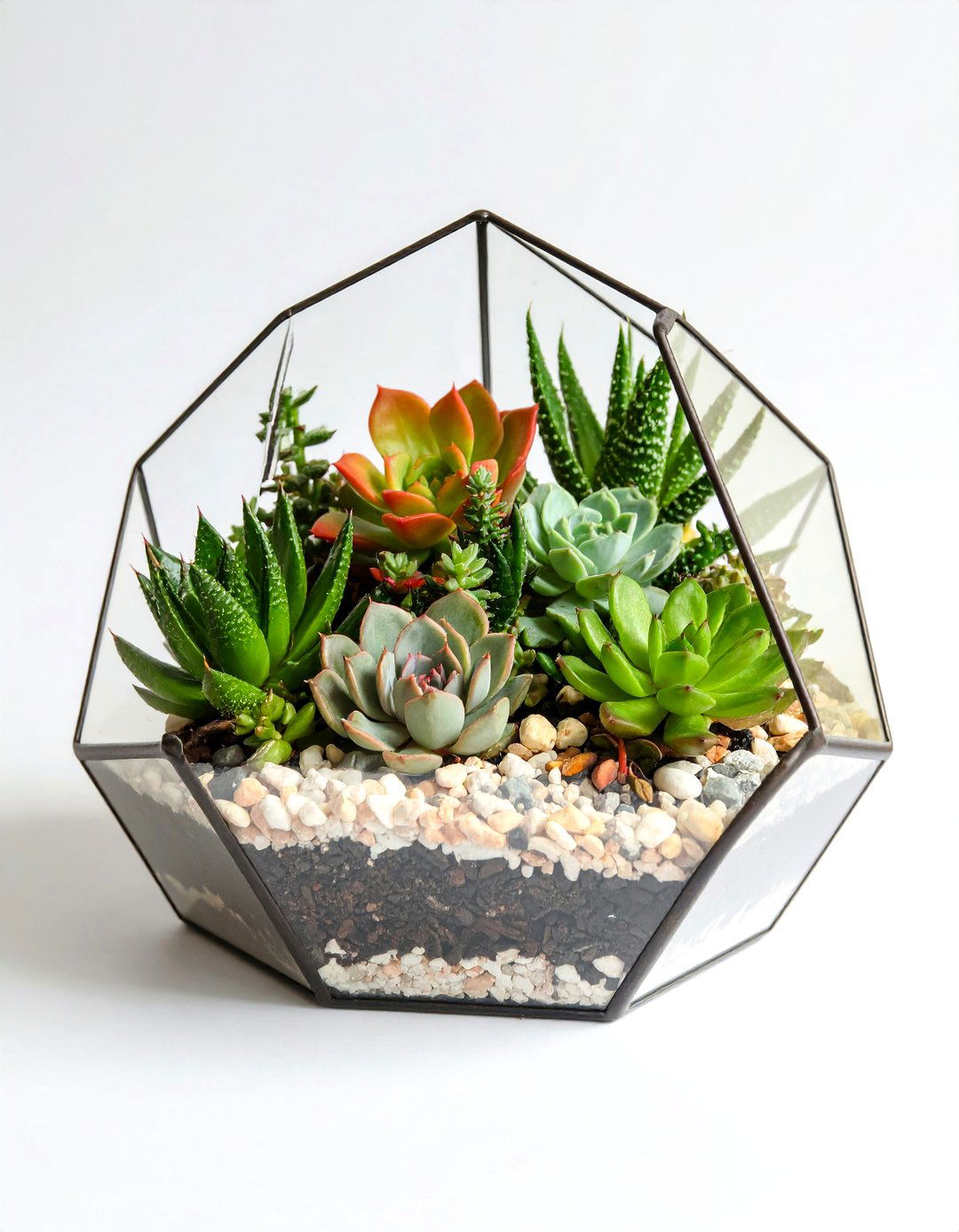
Enchanting fairy garden terrariums invite miniature houses, tiny benches, and whimsical figurines into a closed or open glass container. Use a fine soil mix for small plants like baby’s tears and moss, and arrange accessories to tell a tiny story.
This playful design is ideal for children’s rooms or as a creative gift, blending imaginative play with plant care and inspiring ongoing customization.
9. Geometric Glass Terrarium
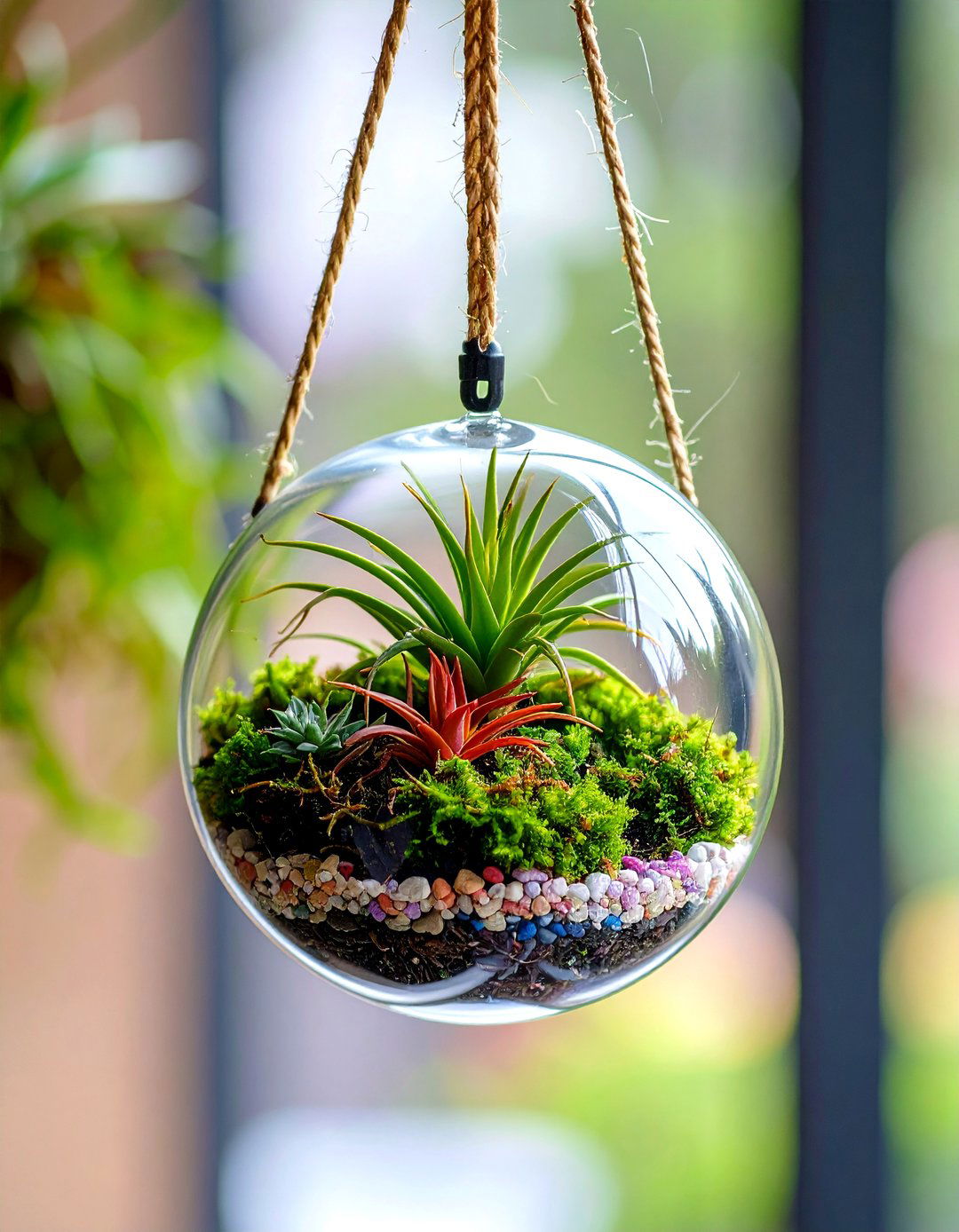
Geometric glass terrariums—such as pentagons, cubes, or icosahedrons—offer a modern aesthetic with sharp lines and open faces. They suit a variety of plant types, from succulents to air plants, and their transparent walls allow full visibility of layered substrates.
These terrariums are often used as standalone art pieces or as grouped displays, leveraging shape and symmetry to complement contemporary interiors.
10. Tinted Glass Beach Terrarium
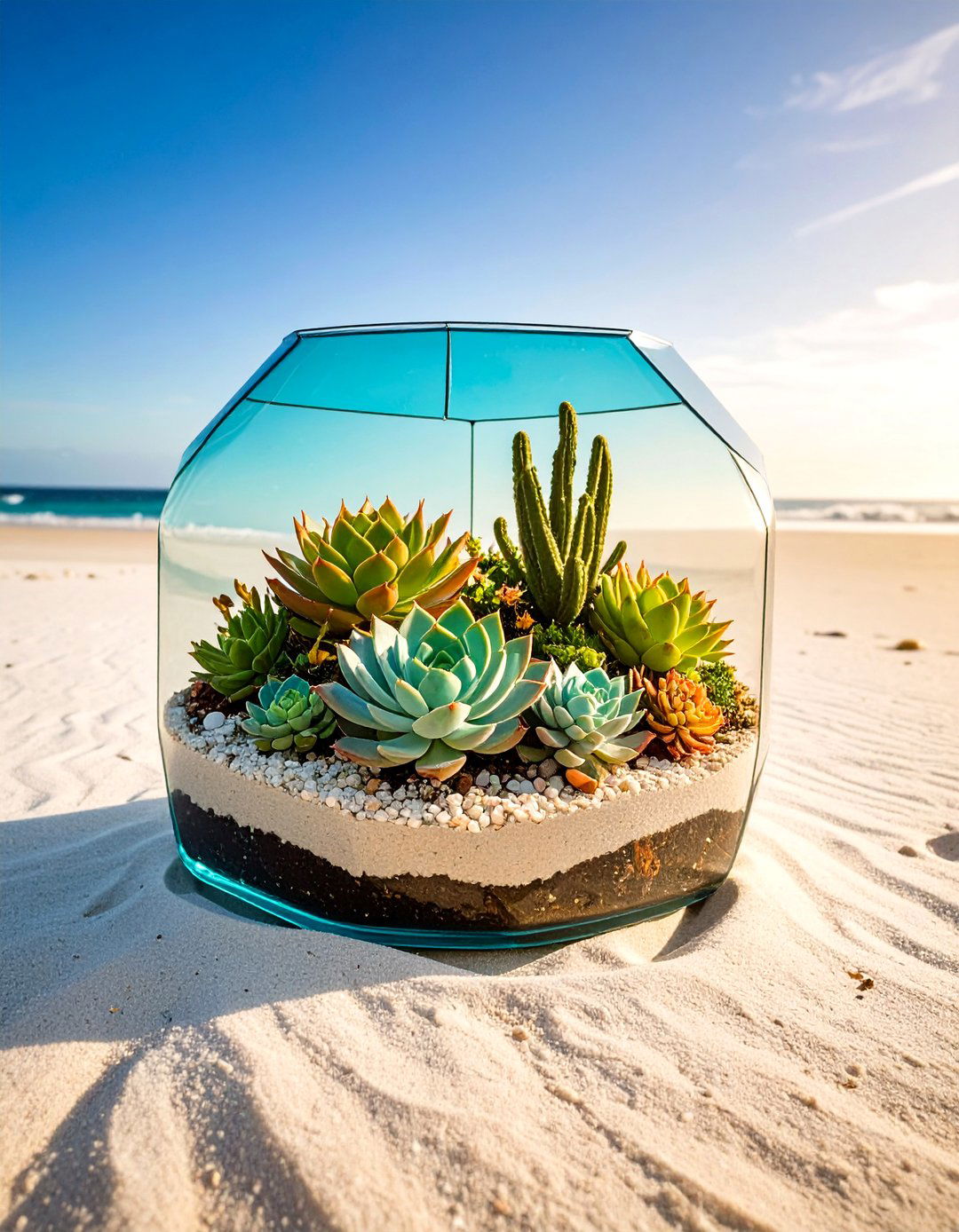
Tinted glass terrariums filter light and add a subtle color wash to your plant display. Use blue or aqua-tinted containers for a marine-inspired theme, layering light sand and selecting pale succulents to maintain a breezy, coastal palette.
Beyond aesthetics, tinted glass can reduce light intensity, providing a gentler environment for sensitive mosses or ferns when used as a closed terrarium.
11. Mini Hanging Terrarium
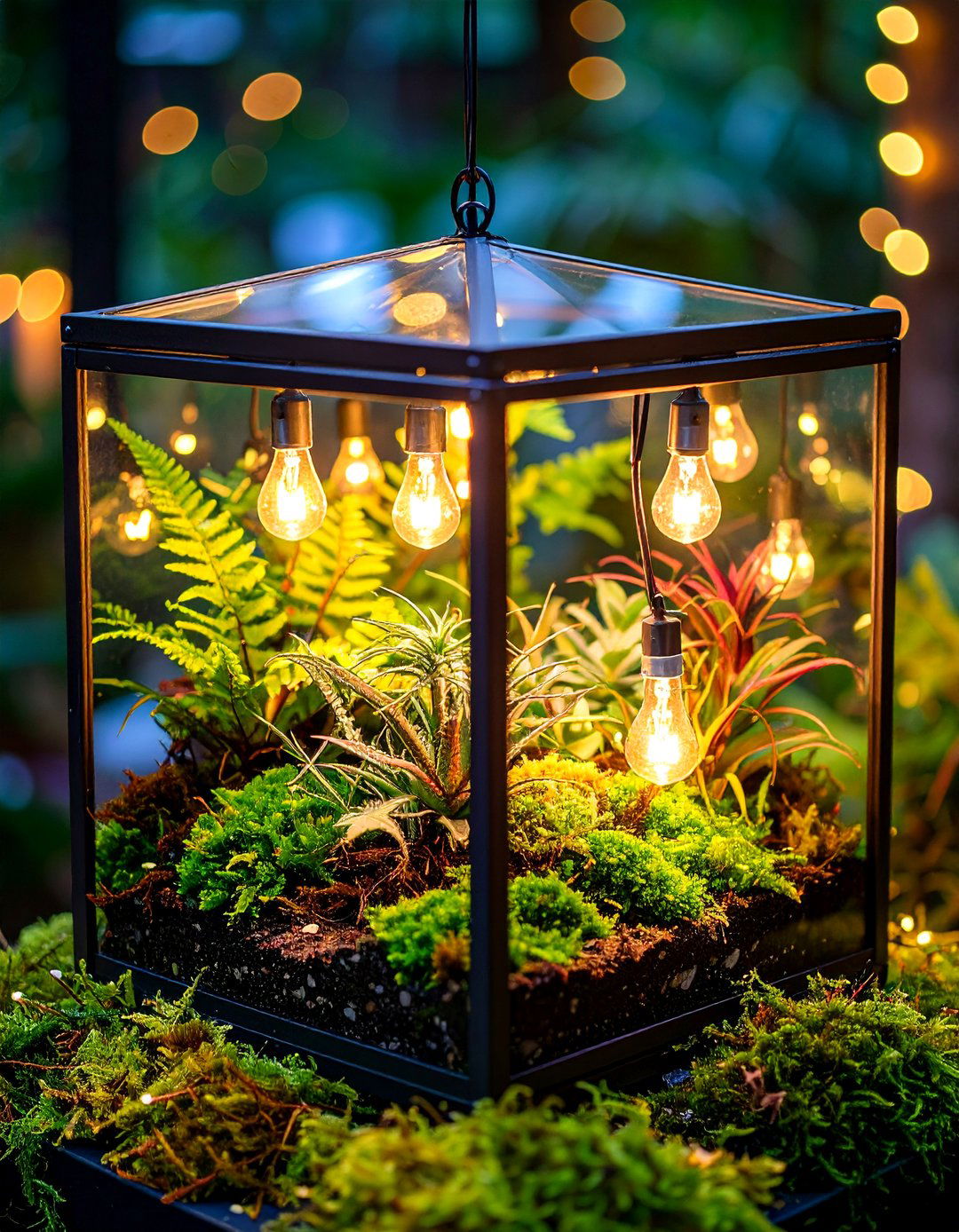
Mini hanging terrariums in tiny globes or bell jars make dainty accents above desks or sinks. Fill with a single air plant or a miniature succulent, plus a base of colored gravel or moss for contrast.
Because of their size, these terrariums need very little care: an occasional mist and bright, indirect light will keep them vibrant without overcrowding a small space.
12. Driftwood Terrarium
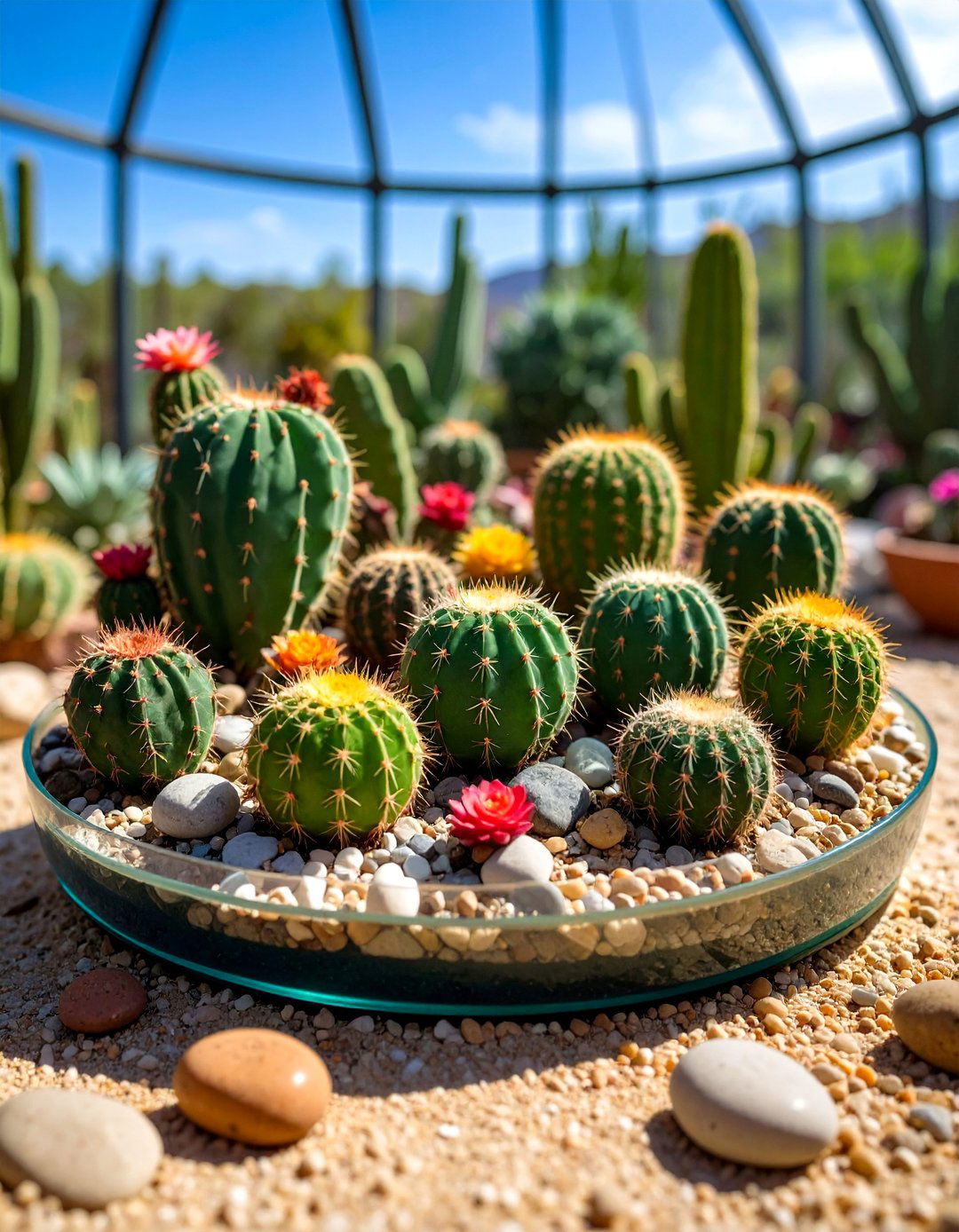
Incorporating driftwood into your terrarium adds an organic, sculptural element. Secure air plants or attach succulent cuttings directly to the wood, creating a vertical or cascading effect.
This style mimics natural epiphytic growth and can be suspended or displayed on a stand, highlighting the contrast between living plants and weathered wood textures.
13. Vintage Bottle Terrarium

Transform antique bottles—such as old perfume or medicine containers—into unique terrariums by inserting moss, air plants, or tiny ferns into their narrow necks. The aged glass and patina add character and historic charm to your micro-garden.
These petite terrariums excel as clustered décor on shelves or windowsills, evoking nostalgia and sustainable upcycling.
14. Cactus Margarita Glass Garden

Repurpose a wide Margarita glass to host a collection of small cacti and succulents, layering sandy substrates and decorative stones to emulate a desert fiesta scene.
This bright, playful presentation works well as a table centerpiece, requiring full sun and careful watering to support the diverse cacti ensemble.
15. Faux Succulent Terrarium
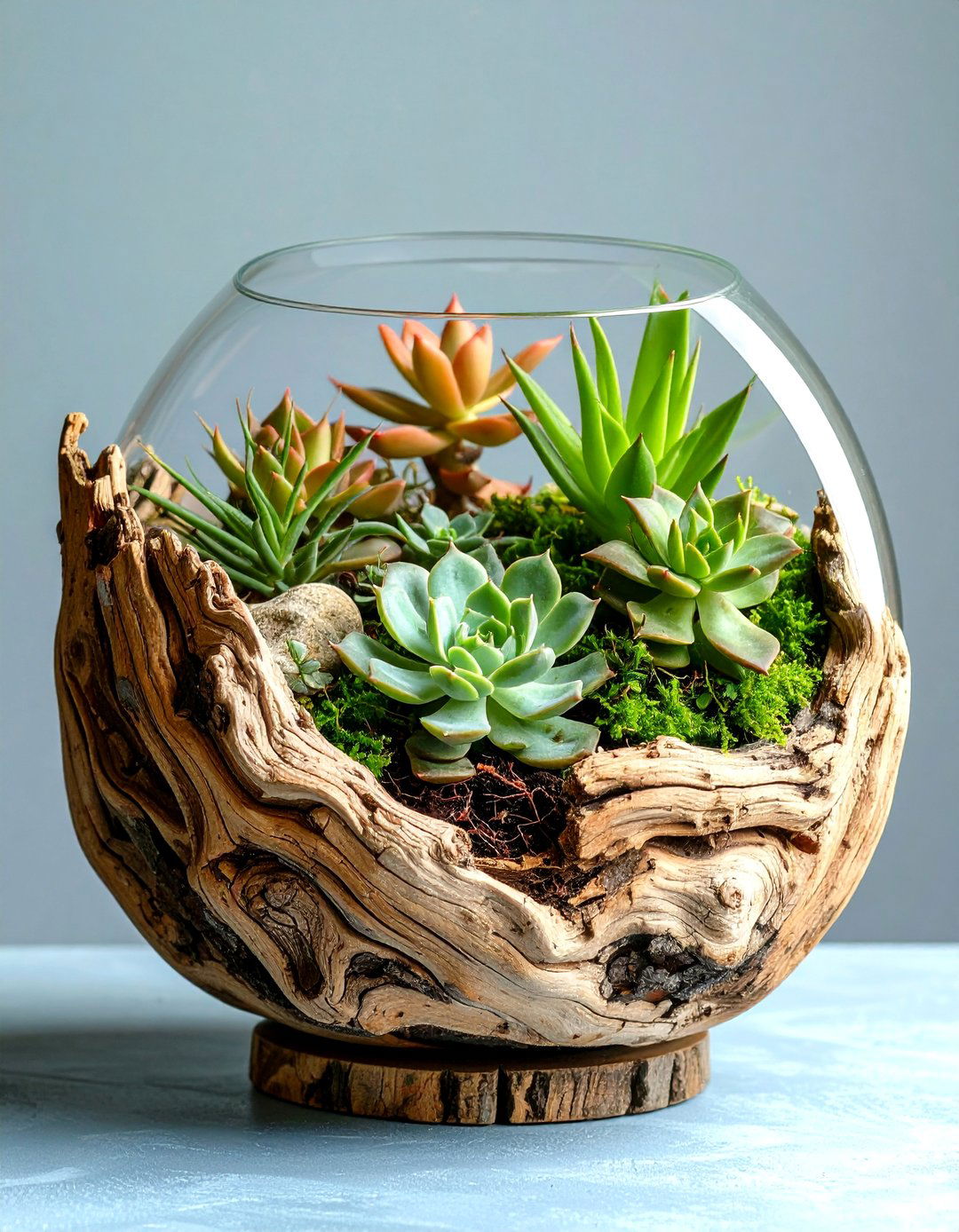
For maintenance-free greenery, craft a faux succulent terrarium using high-quality artificial plants, decorative gravel, and miniature ornaments. Arrange elements just like a live terrarium, securing pieces with floral adhesive if needed.
Faux terrariums suit low-light or unmonitored spaces and retain their appearance indefinitely, providing all the visual appeal without any plant care.
16. Team-Building Succulent Workshop Terrarium
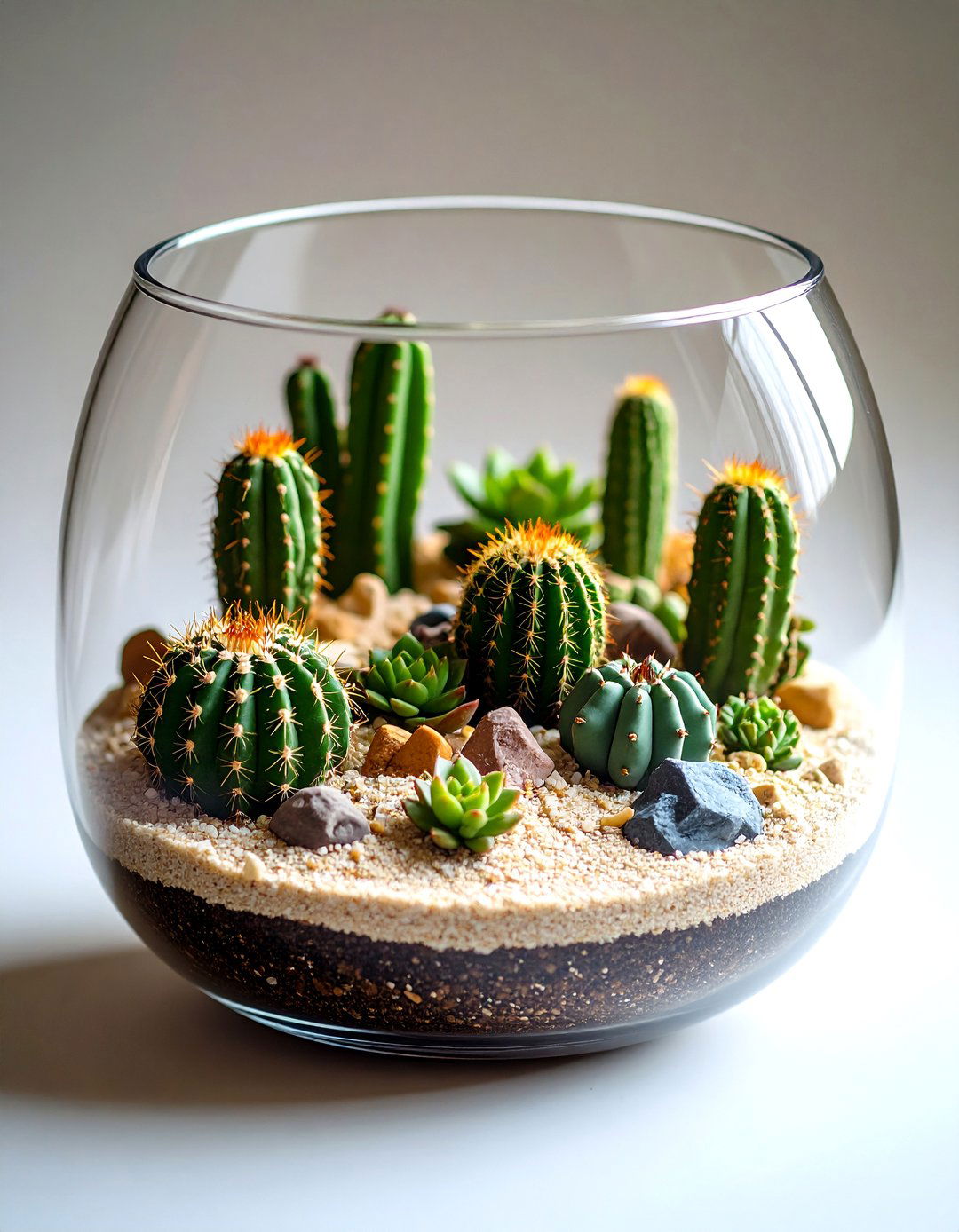
Hosting a terrarium-making event is both social and educational. Provide DIY kits with open glass bowls, substrate layers, succulents, and tools, then guide participants through layering techniques and design tips.
Such workshops foster creativity and collaboration, making them popular corporate or community activities that culminate in personalized living souvenirs.
17. Tropical Rainforest Terrarium
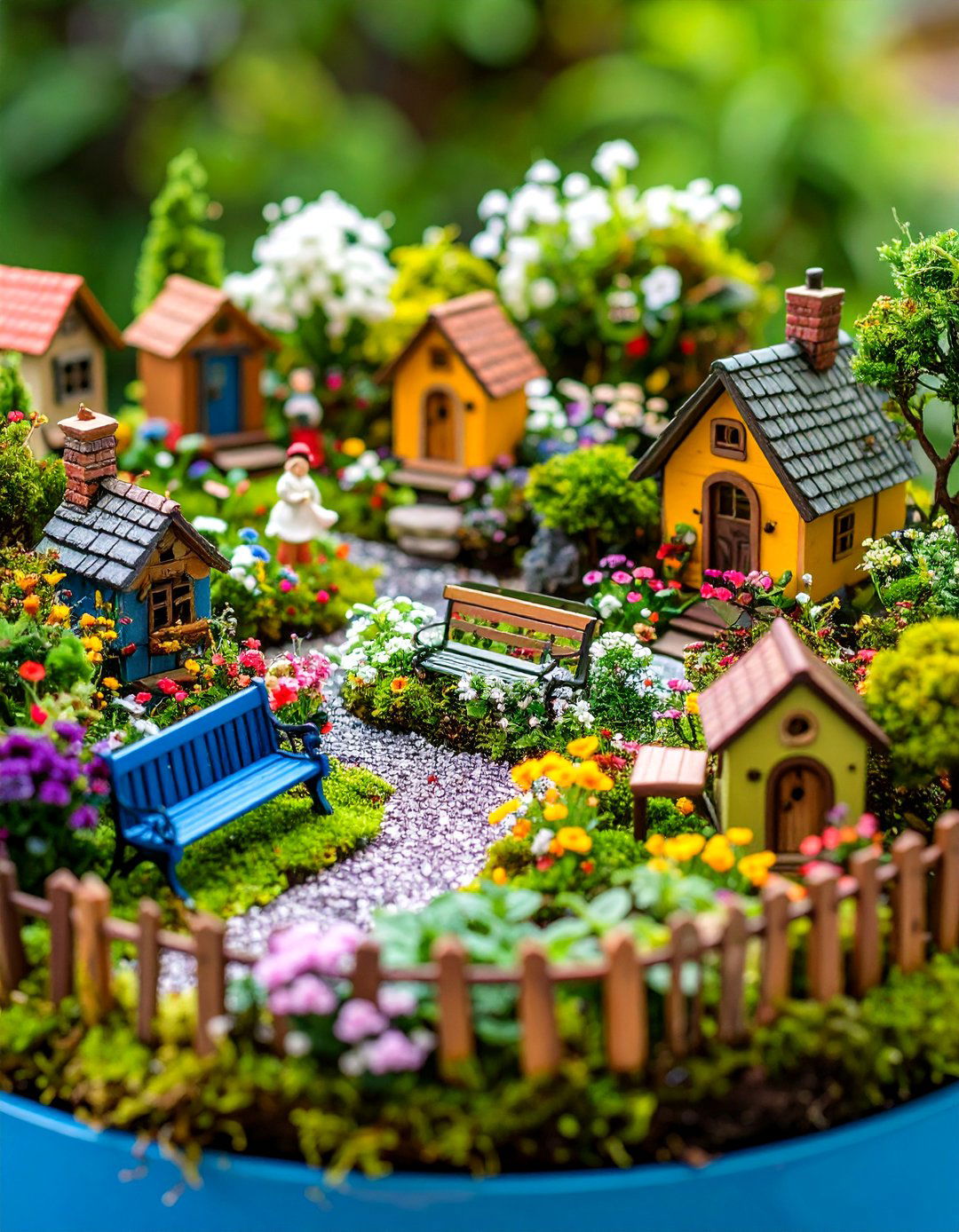
Tropical terrariums recreate humid jungle conditions by housing ferns, bromeliads, and small orchids in sealed glass jars. A base of organic soil mixed with peat moss and silica sand retains moisture, while occasional misting maintains humidity.
This lush, multi-layered ecosystem thrives in bright, indirect light and offers a miniature window into rainforest biodiversity.
18. Paludarium (Aquatic-Terrestrial Hybrid)

Paludariums blend aquatic and terrestrial zones within one container by partitioning water features alongside planted land areas. Fish, shrimp, or aquatic snails can inhabit the water section, while moisture-loving plants climb the land side.
This hybrid design requires filtration for the aquatic portion and careful balance of light to accommodate both fish and plants, resulting in a dynamic, living diorama.
19. Terrarium Centerpiece
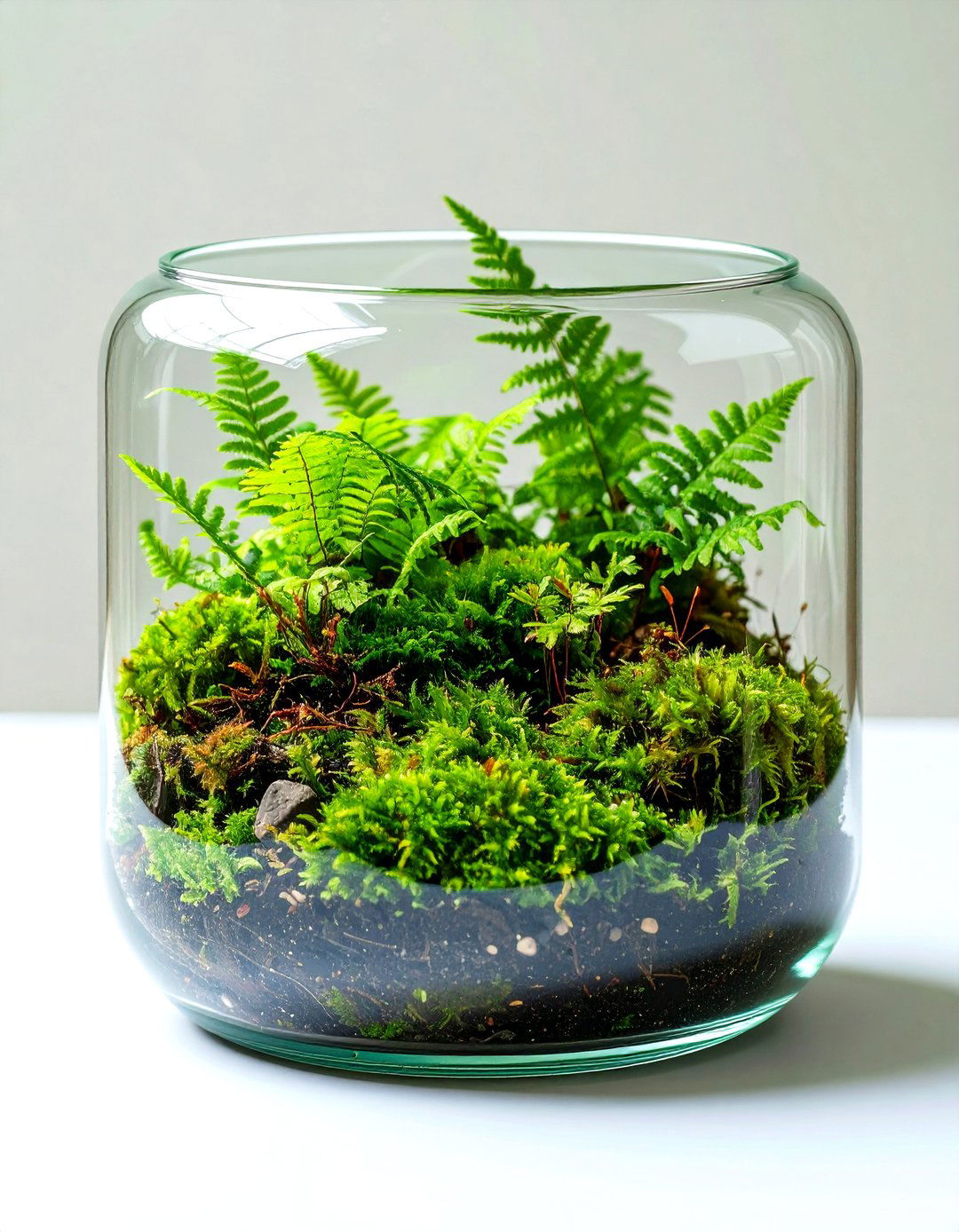
For weddings or events, terrarium centerpieces offer customizable elegance. Choose metal-framed glass boxes or cloches filled with delicate plants like ferns, moss, and air plants, then embellish with string lights or florals.
These centerpieces can be tailored to any color scheme or theme, serving as both décor and guest favors when guests take them home.
20. Seasonal Themed Terrarium

Adapt your terrarium to the seasons: include miniature pumpkins and faux gourds for autumn, holly sprigs and tiny ornaments for winter, pastel blossoms for spring, and seashells for summer. Swap out accessories and refresh substrates as needed to keep the vignette current.
This evolving terrarium model encourages ongoing creativity and ensures your miniature garden reflects the changing year-round mood.
Conclusion:
From classic Mason jars to intricate paludariums, these twenty terrarium ideas demonstrate the rich diversity of container gardening under glass. Whether you’re seeking a low-maintenance accent or an immersive DIY experience, each concept offers unique aesthetic and horticultural rewards. By experimenting with themes, plant selections, and vessel types, you can craft a personalized terrarium that brings a slice of nature’s wonder into your environment, season after season.


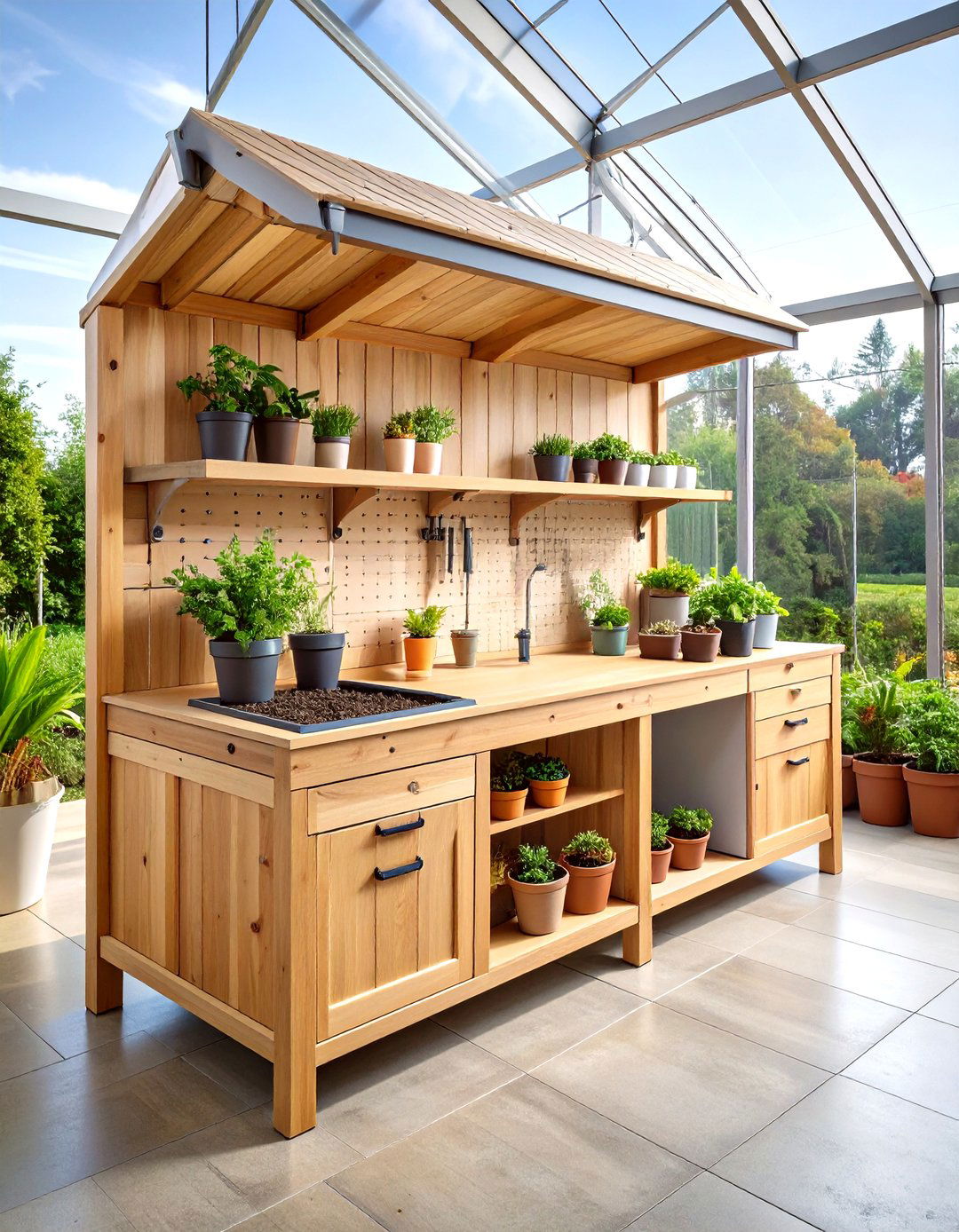
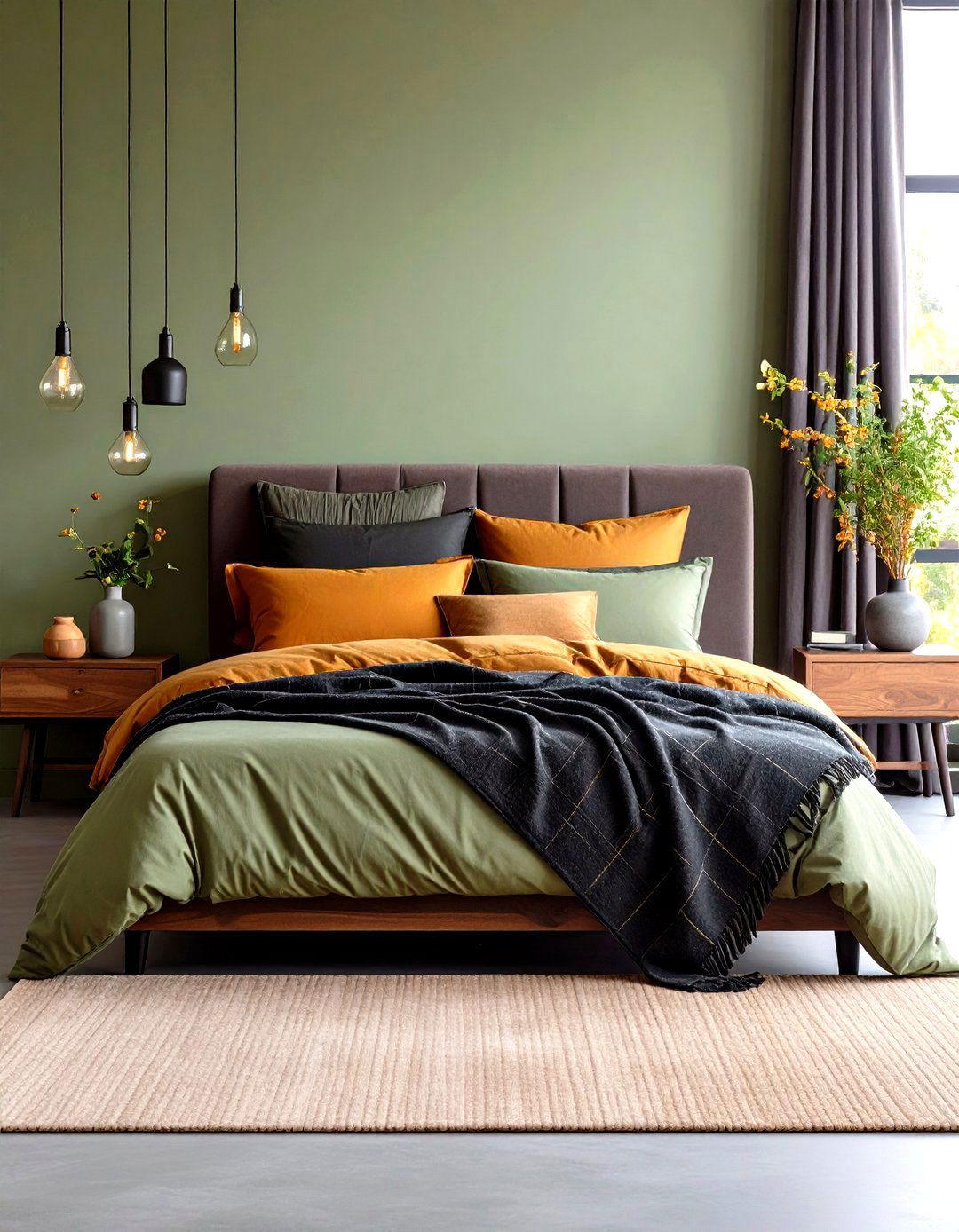

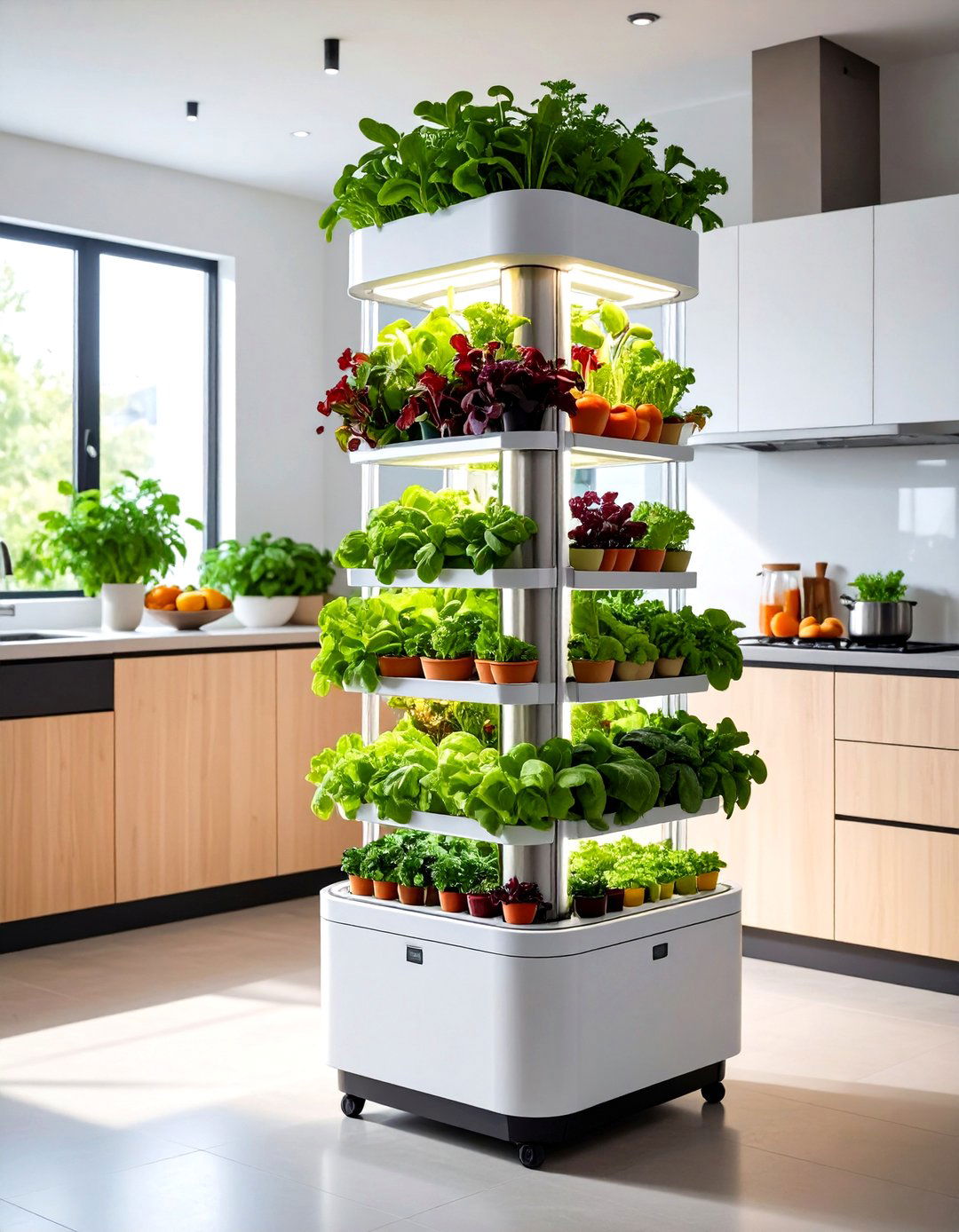



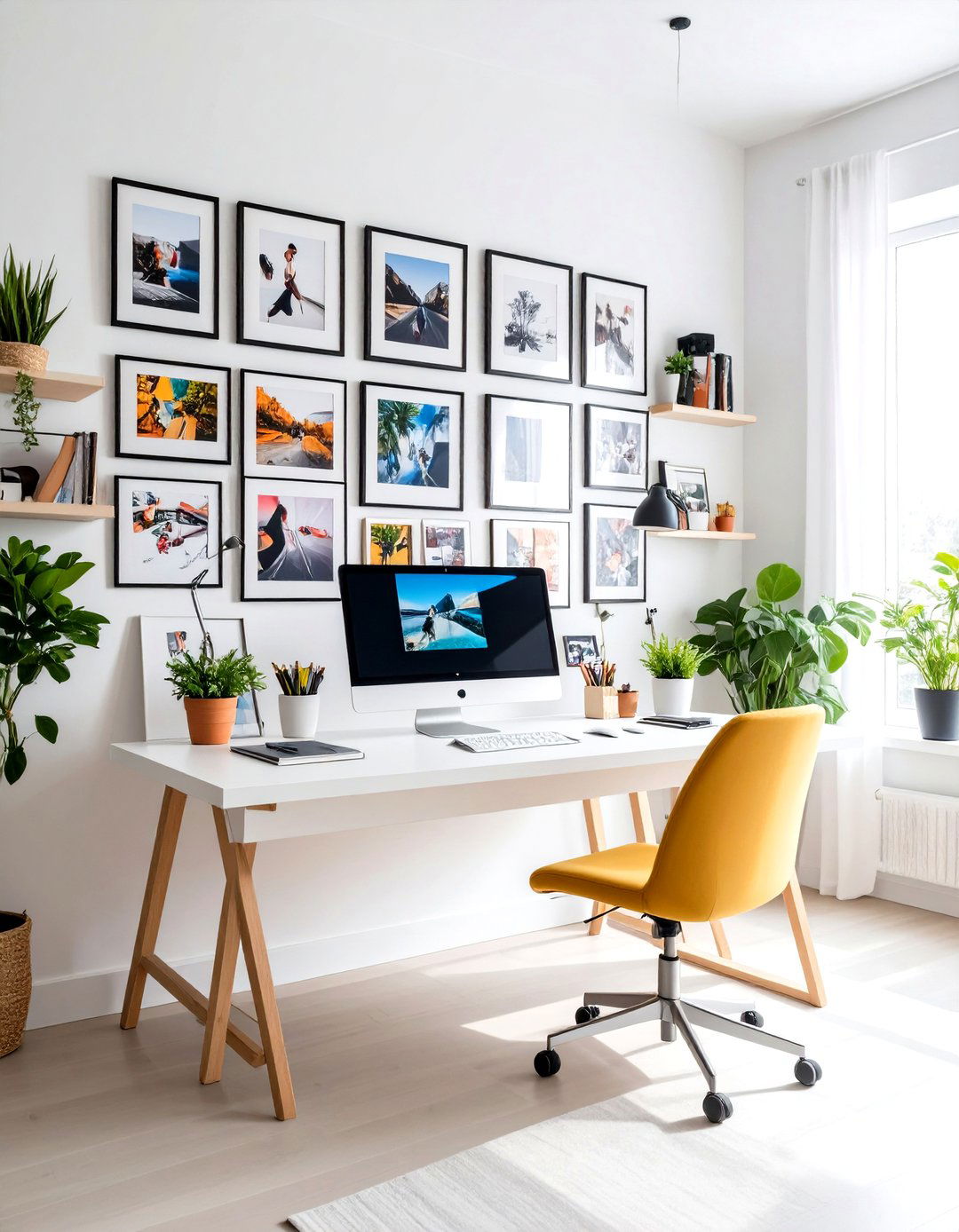
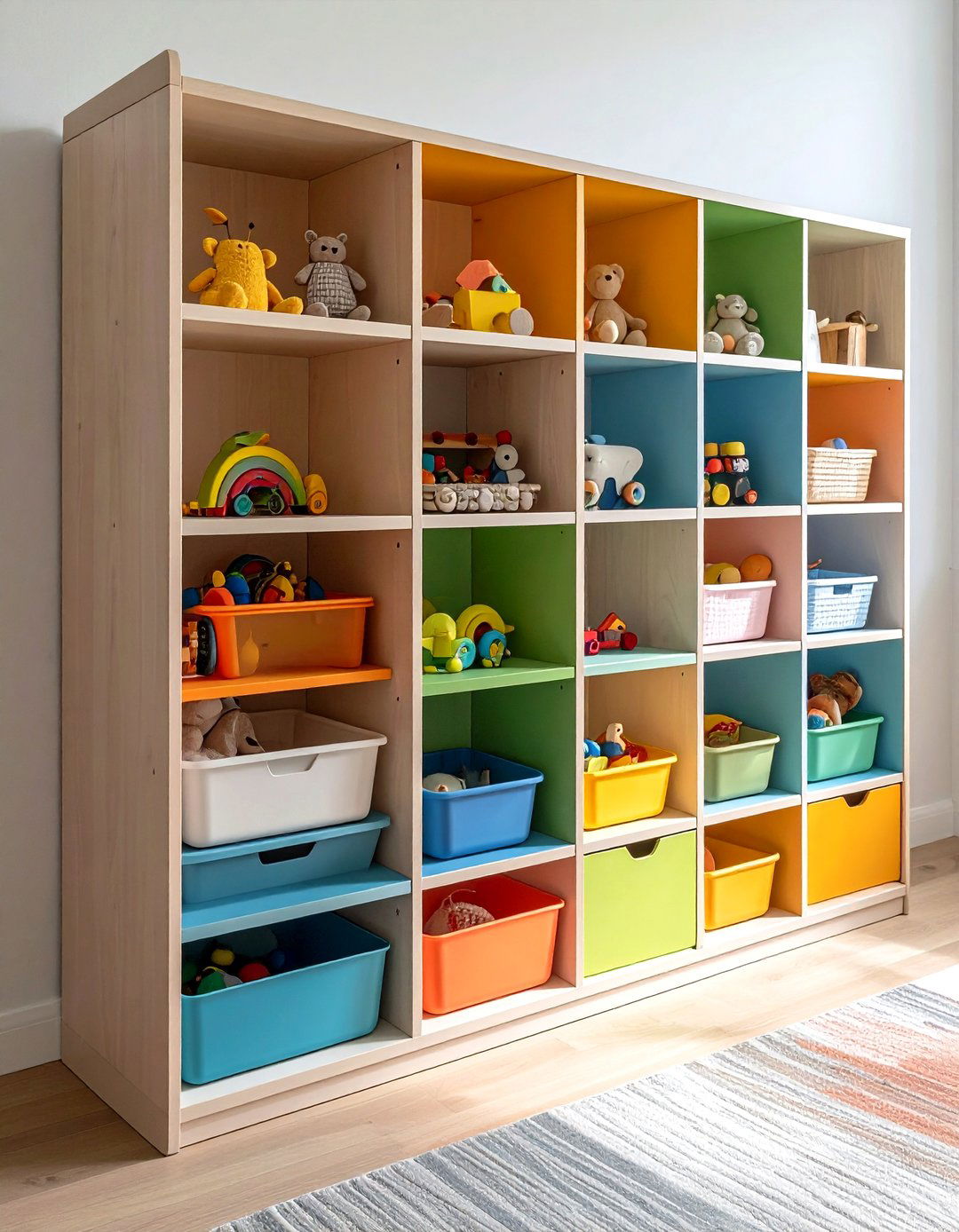

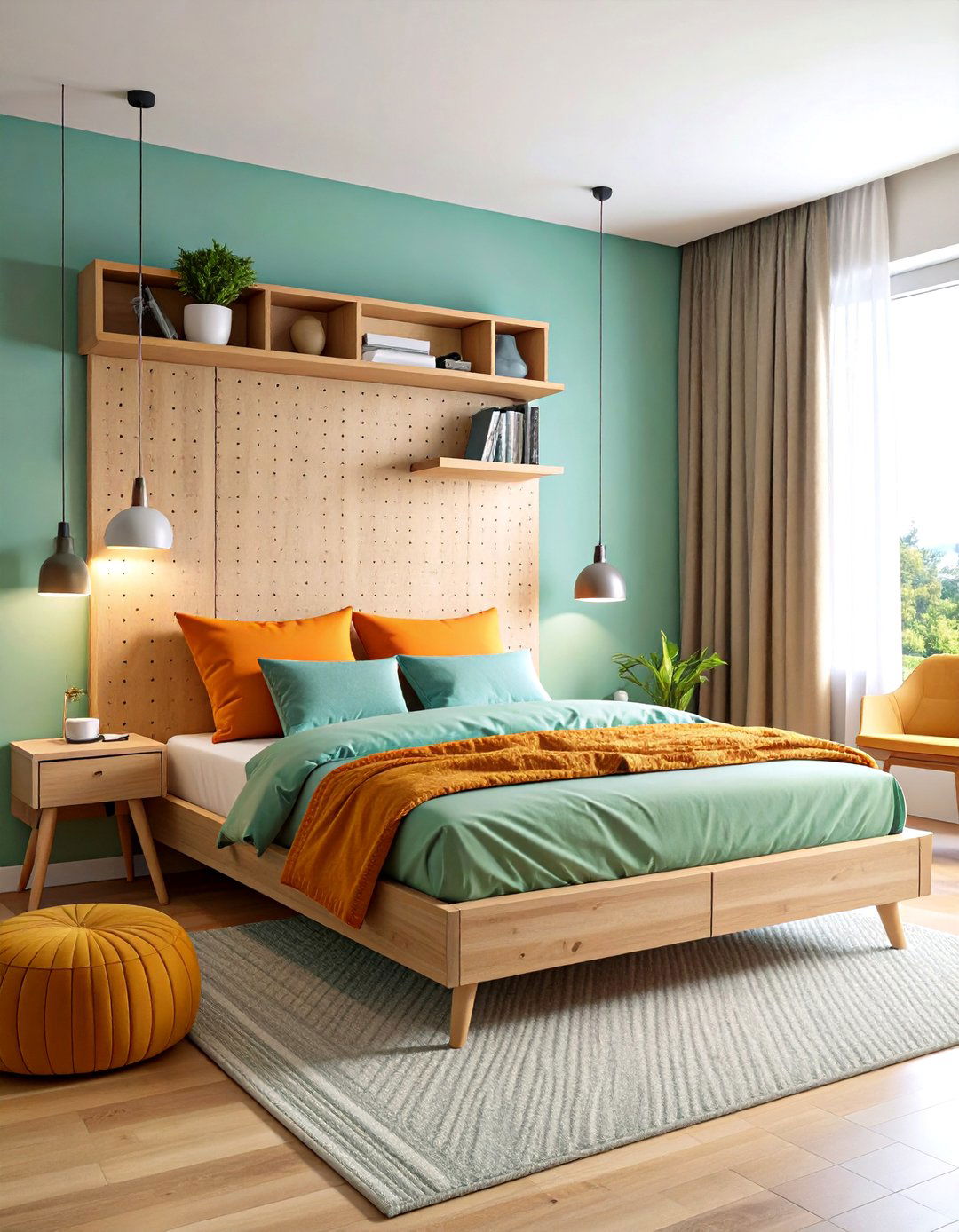

Leave a Reply